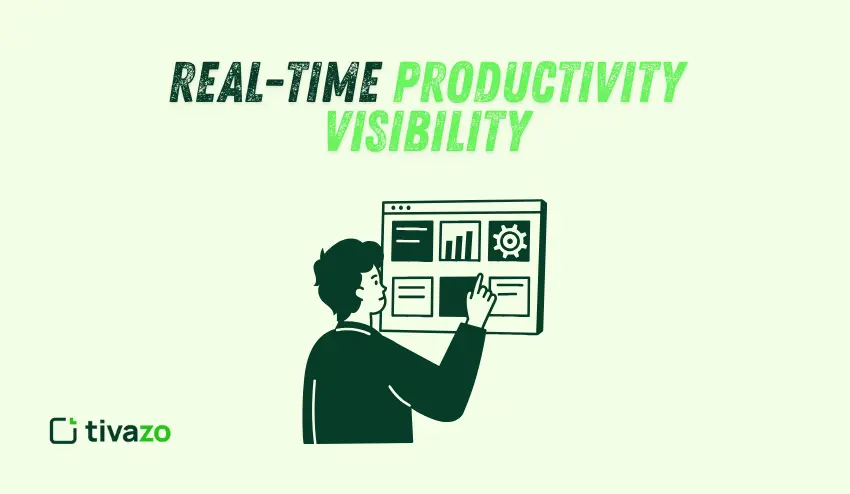Do you ever wish there was just a little more time in the day? Perhaps you’re constantly battling against the clock to keep work, life, and personal projects in balance? Time management is something we can all find a way to improve – and, best of all, you will find no shortage of resources on how to do so.
In this blog, I have compiled a list of 7 of the best books on time management to help you maximize your productivity and regain control of your time. Whether you are a businessman, a student or a professional with myriad responsibilities, these Books on Time Management will provide you with more effective tools and techniques to manage time and achieve your goals. Let’s jump in!
Key Highlights:
- Why Time Management Matters
- Books on Time Management That Will Transform Your Productivity
- Implement Time Management Strategies from These Books
- Why Books on Time Management Are Essential
Why Time Management Matters
Time management is not just about keeping busy. It’s about being productive with your different goals. Time Management gives you the ability to get more done in a shorter amount of time. You will lessen your stress and feel more accomplished. Good time management will increase your productivity, which will, in turn, improve your personal and professional life.
Whether you have a problem with procrastination, if it is hard to juggle your priorities or you just want to improve the way you organize your life, these Books on Time Management will prove to be quite valuable in your life.
7 Books on Time Management That Will Transform Your Productivity
Book #1: Getting Things Done (GTD) by David Allen
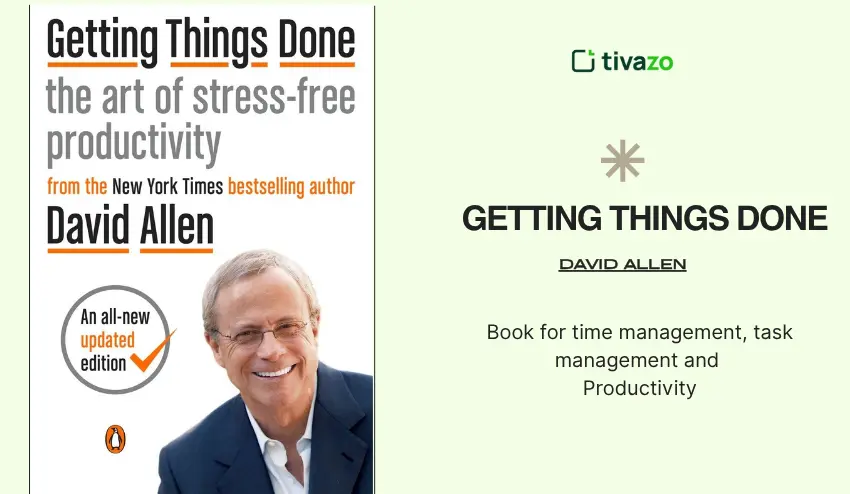
Overview:
Getting Things Done (GTD) is a time management method that provides you with task management, stress relief, and productivity improvement. The goal of David Allen’s system is to free your mind from life’s demands by organizing everything you have to do into actionable lists. The process takes you from being overwhelmed to being in control of your time.
Key Takeaways:
- Capture: You want to write everything down that is on your mind. This includes things you have to do, but also thoughts or ideas. The focus is to get everything out of your head and into a trusted system.
- Clarify: Once captured, you need to clarify whether each task takes action. If it does, determine the next step to take.
- Organize: You are to put tasks into different categories, such as projects, to-do lists, a reminder, and so on. This organizational system is how you will prioritize and get things done.
- Reflect: You want to review the system regularly to keep it fresh. This will allow you to maintain control of — and stay on top of — the things you need to manage without feeling overwhelmed.
- Engage: The Last step is taking action on the tasks. GTD works by organizing everything you need to do, so you know what you are going to do next, producing effortless productivity.
Why It Works:
The GTD process helps clear your mental space by organizing your tasks into something actionable. This helps reduce the stress many of us feel when we see tasks piling up, remembering something we should be doing, and providing confidence that we won’t forget about something. The process of constantly reviewing the tasks helps to fuel productivity as it creates clarity and brings structure into your work.
Book #2: Atomic Habits by James Clear
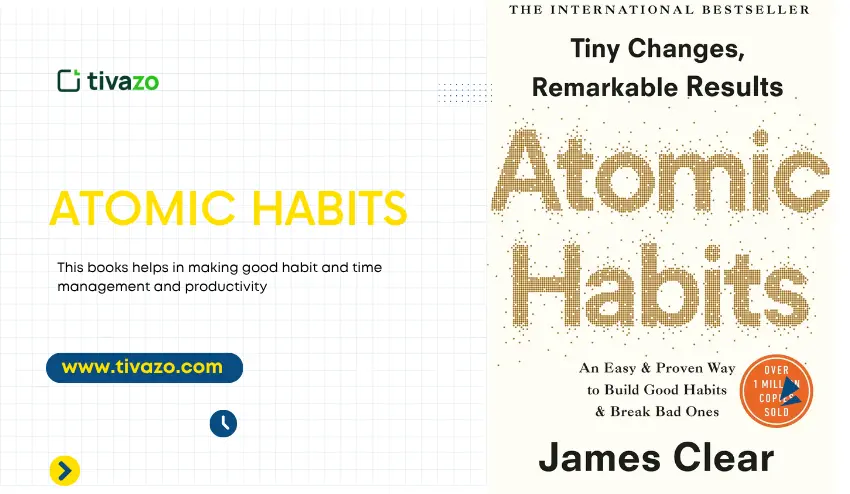
Overview:
Atomic Habits by James Clear is a groundbreaking book about habit formation and A small, consistent change can achieve great things. Instead of always thinking about large goals, Clear focuses on small, incremental improvements that lead to improvements over time, which is where the real change happens is one of the Books on Time Management that helps in a great manner
Key Takeaways:
- The 1% Rule: A tiny change, if done consistently every day, can lead to a big change.
- Habit Stacking: Create a new habit by tying it to an existing habit. For example, if you want to drink more water, drink a glass right after your morning coffee. This effortless pairing creates consistency.
- Environment Design: James recommends, whenever possible, designing your environment for your positive habits to be easier and your bad habits to be harder. A good example is if you want to stop watching TV late at night, remove the remote from your bedroom.
Why It Works:
The principles are simple and easy to implement. They are grounded in the reality of the power of many little actions, done consistently over time. This means if you can make a tiny improvement, you eventually change your behavior, and ultimately your productivity, in a real and perhaps profound way!
Book #3: The One Thing by Gary Keller
Overview:
In The One Thing, Gary Keller teaches us that by focusing on the one most important task at hand, you will simplify your day and increase productivity. Keller pushes back on the idea of multitasking and asks that we instead focus on the one thing that, by doing it, everything else becomes easier or unnecessary.
Key Takeaways:
- Prioritize: Ask yourself, “What is the one thing I can do such that by doing it, everything else will be easier or unnecessary?” This will help you focus on the thing that has an impact.
- Get rid of distractions: Be uncompromising when it comes to unimportant time-sucking activities. This leads to reduced overwhelm and narrow focus.
- Create time blocks: Narrow time allocation to a time block for the most important things.
Why It Works:
By focusing on one thing, you reduce distractions and wrap all of your energy into making substantial progress on the most important things. You become more efficient and eliminate mental clutter generally. Thus, better time management.
Book #4: Essentialism by Greg McKeown
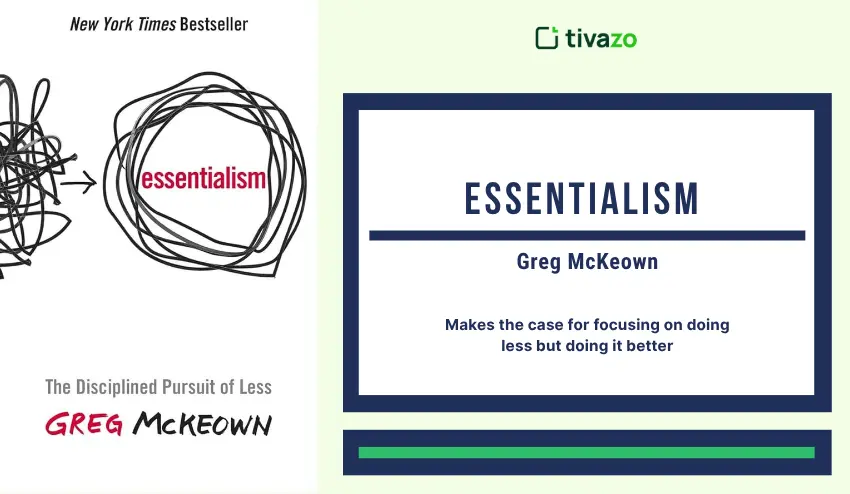
Overview:
Essentialism by Greg McKeown makes the case for focusing on doing less but doing it better. Rather than doing a ton of things, McKeown recommends focusing on the few most important things and saying no to everything else. It’s all about making room for what’s important.
Key Takeaways:
- Eliminate non-essentials: You need to remove tasks that don’t align with your core values and goals.
- Focus: Concentrate on the tasks that will have the largest impact rather than the most urgent.
- Say no: The ability to say no is essential to removing distractions and protecting your time for what’s truly important.
Why It Works:
It works by removing the noise. When you have less to do, you can focus more in-depth on a few tasks, which leads to better quality work and improved productivity. Essentialism services time management by ensuring that you are not wasting time and effort on tasks that aren’t connected to your goals.
Book #5: Eat That Frog! by Brian Tracy
Overview:
Eat That Frog! by Brian Tracy is a personal development book about overcoming procrastination and unleashing your productivity through goal setting and productivity strategies. The main idea of the book revolves around the metaphor of a frog. A frog is the task that you least want to do (which is usually the most important task of the day). The task you least want to do is often the first thing in the morning or very early in the day. If you’re able to start your day by taking care of your “frog”, you will carry a sense of accomplishment with you throughout the rest of your tasks in the day.
Key Takeaways:
- Eat your hardest task first: Your “frog” is the thing you have been avoiding that tends to be your hardest task. You want to get your frog done first thing in the morning; this way you will remove all the dread, and free up some mental real estate for the rest of the day.
- Slicing your tasks: Often, large tasks can seem overwhelming. However, if you slice up the tasks into smaller, manageable pieces, they become less scary.
- Prioritize: You need to have priorities and clear priorities to make sure you work on the most important things first..
Why It Works:
The process just works because it tackles procrastination, enabling more productivity earlier in the workday. After you tackle the “frog”, the rest of the day will feel easier, and you’ll be able to maintain that momentum for the rest of the day.
Book #6: The Pomodoro Technique by Francesco Cirillo

Overview:
The Pomodoro Technique is a simple but powerful productivity technique designed by Francesco Cirillo. The basic idea is to divide your work into 25-minute segments (called Pomodoros) with breaks in between each one. The goal of this technique is to improve focus and concentration while reducing burnout and fatigue.
Key Takeaways:
- Work in 25-minute segments: Intently focus on a task for 25 minutes without distractions.
- Take breaks: After each Pomodoro, take a 5-minute break. After 4 Pomodoros, you take a longer break.
- Set a timer: The Pomodoro Technique involves using a timer to keep track of your time segments, so you don’t lose focus and to ensure you’re taking your breaks.
Why It Works:
The Pomodoro Technique supports sustained focus and concentration while helping to limit mental fatigue. By segmenting your work into smaller, isolated tasks, you can tackle larger projects without feeling overwhelmed. In addition, this is a great strategy for improving your time management while maintaining a clear mind.
Book #7: Deep Work by Cal Newport
Overview:
Deep Work by Cal Newport is about the importance of doing highly focused, undistracted work. Newport makes the case that deep work is required to achieve a high level of productivity and produce a plentiful quantity of high-quality work in a relatively short amount of time.
Key Takeaways:
- Establish deep work sessions: Create specific time slots, coinciding with your class or work schedule. Allocate these specific time amounts to use for deep, uninterrupted work.
- Minimize distractions: Disable notifications, block distracting websites, and create an environment that is conducive to deep work.
- Work in stretches: Newport encourages long, uninterrupted stretches of work; this can help you get much better work done in terms of meaningful work.
Why It Works:
By engaging in deep work, you are able to work on the community, in full concentration, and while surrounded by challenging work to get done. This results in high-quality outcomes, work efficiently, especially when dealing with complex projects, where intrinsically deep work is required.
The Science Behind Time Management: Why These Books on Time Management Matter
Time management is more than just making to-do lists – it’s about how the brain works and managing the tasks we need to do. Research has shown that multitasking, despite the common perception that it increases productivity, leads to less productivity and greater cognitive load. When we switch between tasks, we drain our capacity for cognitive processing and lose focus. This is also why many people rely on professional dissertation writers when handling large, complex writing projects, they help maintain structure and reduce cognitive overload.
That is why deep work and the Pomodoro method are so effective. It adds the ability to focus on one task at a time, allowing us to produce high-quality work with less effort. This creates the ability to structure time and turn distractions down, allowing us to work in unison with our brain, and not against it. These Books on Time Management can provide you with not only one way to be productive, but can provide you with some psychological tools that help improve not only productivity, but stress as well. When we tap into our brain´s capacities, we can accomplish our true potential.
How to Implement Time Management Strategies from These Books on Time Management
Reading is just the first step. To truly reap the benefits, you need to implement the strategies. Start by:
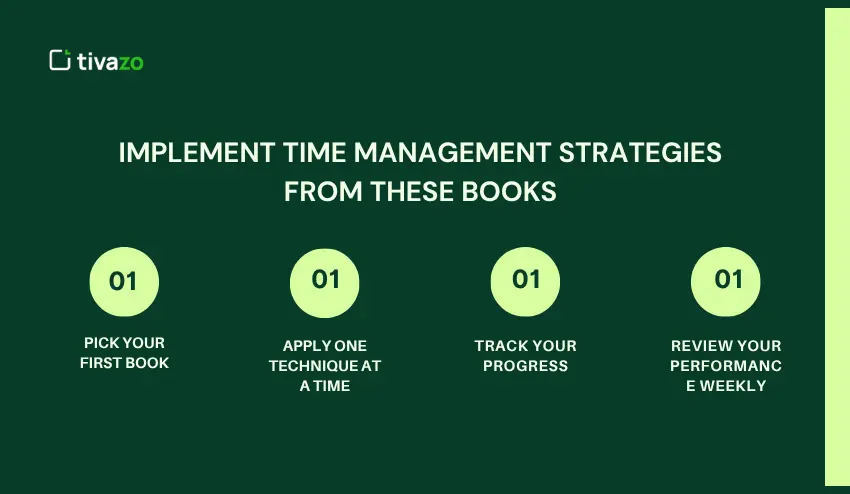
- Pick Your First Book
- It’s time to pick your first book. Choose one book that you can relate to; this will allow you to focus on one thing at a time so that you become overwhelmed. No matter what area you need help with, procrastinating or learning how to prioritize, selecting a book that pertains to you first ensures you are tackling the appropriate priority area of your life. Having solid ground will be beneficial to long-term success, as you will be able to absorb the content better and take your time implementing one thing at a time. you find that you’re struggling with writing or analysis while implementing these time management strategies, you can always order an essay to relieve the pressure, or set up an academic space to practice writing and analysis to develop your skills while using the book’s techniques.
- Apply One Technique at a Time
- Now that you have selected your book, decide on one time management technique to implement at a time. Choose to read Eat That Frog to eliminate procrastination, or use the Pomodoro Technique to create focus. Be diligent about focusing on one method until it becomes a habitual part of your routine. It is important to stay focused on one area at a time so that you do not become overwhelmed and so that you can build consistent habits over time. Learning one method at a time, while being consistent and building on where you add each new method, leads to an increased chance for success as you find the best system that works for you.
- Track Your Progress
- Using Tivazo to track how much time you’re spending on tasks will help you measure your activity level. Tivazo will give you real insights into how well you are managing your time. This will reveal where your time is going and show you which tasks/resources, and techniques are taking longer than they need to, as well as showing you which ones are working best for you in terms of getting things done. The more you keep track of your progress, the easier it is to stay accountable, and the more it motivates you to keep improving.
- Review Your Performance Weekly
- After each week, review what worked and what didn’t. Think about your week, celebrate your little wins, and see what you need to get better at. Use this review to tweak your approach for the next week and make sure you are following through on all aspects of your plan. It is important to review your week or next week to assess your progress, and help you with adjustment strategies to continually move forward as needed.
Why Books on Time Management Are Essential in the Modern Workplace
The pace and pressure in today’s working climate is higher than ever and many people are being asked to get more done in less time, with no room for mistakes or errors, and Books on Time Management are more than just about organization. They are your surest way to stay moslty sane, and hopefully become more productive in a high-pressure, demanding world. By using the strategies in these books, you will be able to prioritize effectively, reduce stress levels, and greatly improve your work-life balance while also being able to complete more higher-quality work in a more timely manner. For example, if you’re struggling with academic tasks, consider how you can write your essay with AI to save time and still produce high-quality work, freeing up more time for other priorities.
These books will help you take control of the day, working smarter and not harder. They also teach you how to use your time better, and eliminate distractions, identify high-value tasks, and to create a system that allows you to stay in control. Can you imagine getting more done with less effort and feeling empowered, not feeling overwhelmed? Remember, Time Management is not just a skill-it is a superpower that gives you the clarity to win and the freedom to enjoy the time you have beyond the workplace.
Summary
Time is your greatest asset. By implementing the techniques outlined in each of these 7 Books on Time Management, you will be able to release your full potential, increase productivity, and achieve your desired objectives. Whether you are struggling with procrastination, overwhelmed with a to-do list, or looking for more efficient methods of time management, these Books on Time Management will help you get back in control of your time and your schedule.
Call to Action: Choose one of these books today and start applying its techniques. Let us know your progress in the comments and how it has improved your productivity!


